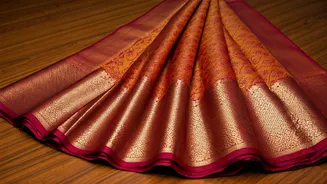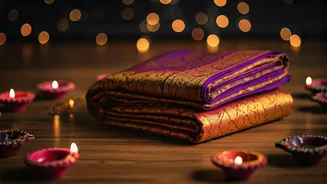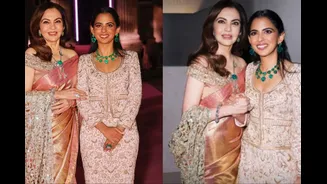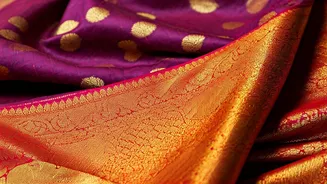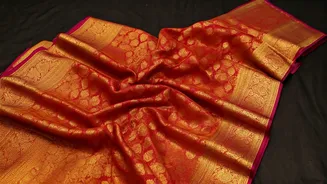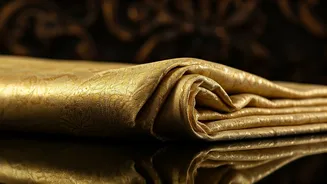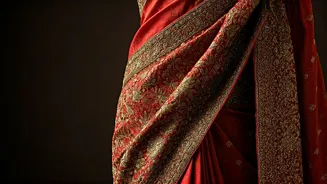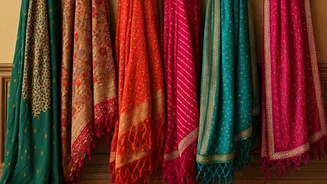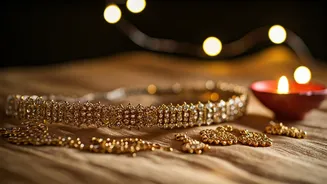Weave and Fabric
The fabric is a primary indicator of a genuine Banarasi saree, and the weave is its essence. Authentic sarees are typically made from pure silk, although
other blends may exist. The silk should feel luxurious to the touch; if the fabric feels rough or coarse, this may be a sign of a synthetic or mixed weave. Examine the weave closely to discern the quality of the craftsmanship. A genuine Banarasi saree showcases intricate designs woven directly into the fabric, using techniques like 'kadwa' or 'ektara' weaving, which involve individual threads for each design element. The weave will create a heavy, durable fabric, often with a slight sheen from the silk. The backside of the saree reveals the detailed work of the weave. The design elements will be clean and clear, indicating meticulous craftsmanship, unlike imitations that might feature simpler, printed patterns.
Motif and Design
Banarasi sarees are characterized by their elaborate motifs, which are not just decorations but are integral parts of the saree's identity. The motifs often incorporate traditional Indian designs like floral patterns, paisleys (known as 'butas'), and intricate geometric shapes. The 'zari' work, using metallic threads, is a key aspect of the design, which is typically gold or silver. In an authentic saree, the zari is woven, not just printed, and is intricately integrated into the overall design. When choosing a saree, pay attention to the details of the motifs; the finer the detailing, the more likely the saree is genuine. Motifs that are uneven, blurry, or loosely attached to the fabric might indicate a less authentic piece. The density and arrangement of the motifs also play a role: genuine Banarasi sarees often have a dense array of patterns, creating a visually rich and textured look.
Zari Quality Test
The zari, or metallic thread used in Banarasi sarees, is often made with gold or silver, or a combination of metallic and silk threads. The quality of the zari is a significant indicator of a saree's authenticity. A simple test to determine the quality of the zari involves rubbing a small section of the thread between your fingers; if the color fades or transfers easily, the zari is likely of lower quality. In authentic sarees, the zari should retain its luster and color. The feel and weight of the zari are also important. Real zari will add a noticeable weight to the saree due to the metallic content. Examine the borders and the body of the saree to assess the zari work; the more detailed and well-crafted the zari, the more authentic the saree is likely to be. Cheaper versions may use imitation materials that lack the shine and durability of genuine zari.
Color and Dyeing
The colors used in Banarasi sarees and how they are dyed are critical in assessing the authenticity. Genuine sarees use natural or high-quality dyes that result in rich, long-lasting colors. Examine the saree in natural light to fully appreciate the color. Colors in a real Banarasi saree will appear deep and vibrant, without looking faded or washed out. A simple test for the quality of the dye is to gently rub a damp, white cloth over a colored area of the saree; if the color transfers, it is an indication of poor-quality dyeing. Look at the saree's intricate details, as each thread and motif is dyed separately before weaving, and the quality of the dye will determine how well the pattern looks. In addition, original sarees typically feature multiple colors with sharp distinctions. This is due to the process of individual thread dyeing.
Price and Source
Price and the source from where you purchase the saree are very significant factors in verifying authenticity. Banarasi sarees are known for their intricate handcraft and high-quality materials, which translates to a higher price point. If a Banarasi saree seems unusually cheap, it is likely an imitation. Genuine sarees often require weeks or months to create, reflecting the value of the craftsmanship. Buy sarees from established retailers or reputable vendors known for their quality. Before buying, check the seller's reputation by reading reviews and testimonials. If possible, consider visiting a physical store where you can examine the saree closely and ask questions. In addition to the purchase price, the availability of a certificate of authenticity from the vendor is a great way to confirm that the saree is a genuine Banarasi product.
